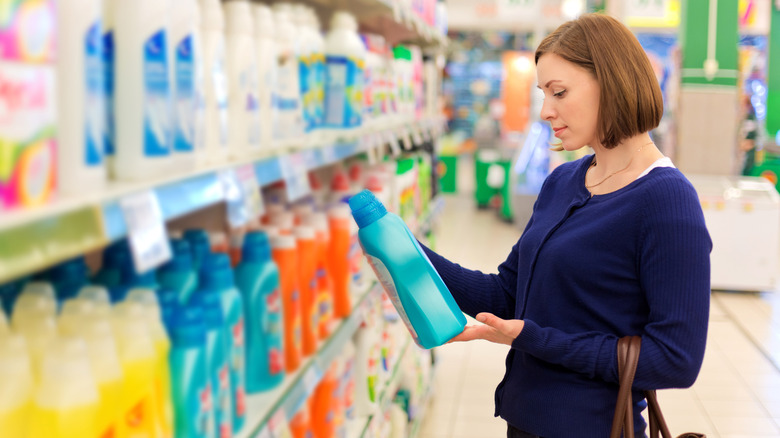Red Flags You Should Watch For When Buying A Laundry Detergent
We may receive a commission on purchases made from links.
When it comes to buying laundry detergent, it's common for shoppers to pick up any brand that's recognizable, budget-friendly, and smells good. You may also make your decision based on what type of detergent you need for your machine, which is why it's important to know the differences between powder and liquid laundry detergents. However, depending on their ingredients, some of these features can also come at a cost to both your health and the environment. A fragrance-free formula is generally a good rule of thumb when you're dealing with sensitive or eczema-prone skin. For other situations, it's also worth looking at laundry detergent labels to avoid other red flag ingredients, including ethoxylated ingredients and surfactants.
When considering toxic laundry room staples to avoid, fragrances are among the first red flags in a prospective detergent. Despite their fresh scents, these artificial ingredients can irritate your skin, and possibly further disrupt your skin barrier if yours is already on the sensitive side. It's even still possible for a detergent to be labeled as "unscented" but still contains fragrances used to neutralize other scents. Some companies simply label chemicals as "fragrance," which can leave shoppers in the dark about the exact product composition. For these reasons, you may want to steer clear of any detergent that does not specifically state the product is "fragrance-free."
Consider skipping on synthetic sulfates and ethylated ingredients
As a rule of thumb, experts recommend reading specific ingredient labels on a prospective laundry detergent rather than going by marketing phrases that might indicate the product is safer than it is. These can include "gentle," "unscented," and "clean and clear." However, even the ingredient labels can be confusing at times, especially when you come across general terms such as "surfactants." If a label doesn't specify what these are, you may be better off passing on the detergent. For example, some common surfactants are synthetic-based chemicals linked with skin irritation and environmental harm, including sodium lauryl sulfate and sodium laureth sulfate.
Any laundry detergent containing ethoxylated ingredients are also considered red flags. These chemicals undergo ethoxylation, which means the ingredients are combined with ethylene oxide to make them softer. However, experts believe these really are not safe in the long-term. This is all thanks to a byproduct called 1,4-dioxane, which is considered a possible human carcinogen. To make matters more complicated, most lanudry detergent companies do not list ethylene oxide and its byproducts on their labels. You can, however, steer clear of some related chemicals such as polysorbates and polyethylene glycol. One example of a product that is free of the aforementioned red flag-ingredients is Puracy Laundry Detergent Free and Clear. While the cleaning power of gentle detergents may not be as strong against tough stains, products with fewer red flag ingredients may be better alternatives to consider for regular use.

